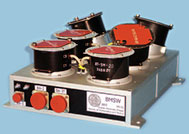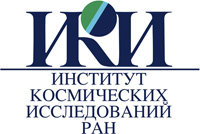About Plasma-F experiment
Project Goal – direct satellite measurements of plasma and magnetic field in the interplanetary medium and the Earth’s magnetosphere.
The space in the Earth's vicinity is called the Earth’s magnetosphere. This is an area, where charged particles' behavior (protons, various ions and electrons) is determined by the Earth’s magnetic field. In the absence of other forces the magnetosphere would be a sphere-shaped “bubble”. However, since the Earth is immersed in the solar wind flow, coming from the Sun, the magnetosphere’s shape changes. It is pressed from the sunward side and extended on the other side. Thus, the so-called magnetotail is formed. The distance from the Earth to the magnetopause (the magnetosphere boundary) towards the Sun is 60 000 kilometers, and to the Earth’s bow shock – 90 000 kilometers. The magnetotail extends in the direction opposite to the Sun for millions of kilometers.
Observations of the Earth’s magnetosphere and the solar wind influencing it are essential to understand solar-terrestrial relations, in particular, for studies and forecasts of 'space weather' (this term relates to the state of the near-Earth space environment depending on solar activity).
However, there were no such experiments in Russia since 2000 after the Interball-1 spacecraft finished its work. Meanwhile, there are currently more than 10 satellites of foreign space agencies in the near-Earth space and outside it observing the state of the Earth’s magnetosphere and the solar wind.
The "SPECTR-R" spacecraft's orbit will provide a unique opportunity to measure plasma parameters both inside as well as beyond the Earth’s magnetosphere. The orbital parameters are as following: the period 8.2 days, apogee – about 333 570 kilometers, perigee – 576 kilometers.
During 7-8 days the spacecraft will spend outside the magnetosphere, thus allowing almost persistent monitoring of interplanetary medium and space near the orbit of our planet. Then, it will pass the magnetosphere with the chance to study it's different areas.
Such experiment will be Russian contribution to international programs of multi-satellite measurements devoted to space weather and magnetospheric research.
"PLASMA-F" Experiment Main Scientific Tasks:
- to monitor interplanetary medium for the purpose of space weather studies and forecasts;
- to study solar wind turbulence;
- to study energetic particles acceleration processes.
Principal investigator of the plasma-magnetic experiment "PLASMA-F" is Lev Zelenyi, academician of the RAS, director of Space Research Institute of the RAS (IKI).
For more information please contact:
- Dr. Georgiy Zastenker, leading research scientist of IKI RAS +7-495-333-13-88, gzastenk@iki.rssi.ru
- Dr. Alexander Skalskiy, senior research scientist of IKI RAS +7-495-333-40-24, skalsky@iki.rssi.ru
- Dr. Anatoliy Petrukovich, head of department in IKI RAS +7-495-333-32-67, apetruko@iki.rssi.ru
- Dr. Chesalin Lev Sergeevich, head of department in IKI RAS +7-495-333-30-67, lchesali@iki.rssi.ru
Web page of the "Radioastron" project


